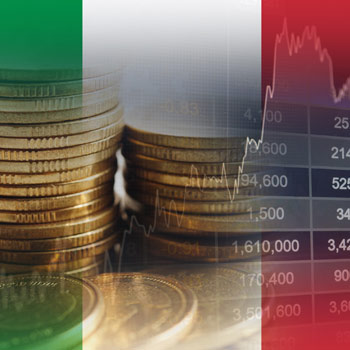
What should I know before trading the Italian FTSE MIB index?
Firstly we shall take a few moments to present the Italian FTSE MIB stock market index in a little more detail. This index, previously known as the S&P MIB, has been managed by the Financial Times Stock Exchange Group since June 2009. Its objective is to track the performance of the assets quoted on the Milan stock market, or the Milano Borsa or MIB, which has been a subsidiary of the London Stock Exchange Group since 2007.
Also called the ‘Italy 40’, the FTSE MIB is composed of 40 assets from companies listed on this index according to the weighting mechanism which is proportional to the volume of their share market capital and also through a selection completed according to the liquidity of the assets as well as the importance of the activity sector. These 40 assets in fact represent over 80% of the total stock market capital of this financial marketplace.
It should be noted that the composition of this stock market index is subject to a quarterly revision. The FTSE MIB also serves as an underlying asset for a number of financial derivatives such as trackers.
Among the assets included in this stock market index and highly weighted in its calculation we particularly note shares of the ENI Company in the gas and petroleum sector, as well as Intesa Sanpaolo and Unicredit, Enel and Generali.
Historically it is important to remember that the Milan stock market was created in January 1808 by Eugène de Beauharnais under the name Bolsa di Commercio. This was originally a public financial marketplace until 1998 when it was privatised. In October 2007, following an acquisition, this stock market was merged with that of London which then became the London Stock Exchange Group. Later, in 2016, the LSEG announced its merger with the German stock market, the Deutsche Börse.
Trade the FTSE MIB with CFD!82% of retail CFD accounts lose money - Plus500.com
Calculation and capital of the FTSE MIB:
We shall now pass quickly on to the subject at hand, the method used for the calculation of the FTSE MIB stock market index. This is called ‘the floating method’. This term is also used in the share trading world and enables the determination of the number of shares available on a market for the general public to buy or sell. As a comparison, the full stock market capital calculates all the shares in circulation that are available.
Given that the value of each asset changes continuously, the total stock market capital of this index also changes continuously. The floating stock market capital only takes into account the shares of companies that are available on the stock markets and not all the assets of these companies.
Still relating to the FTSE MIB index, it is composed of 40 companies quoted on the Bolsa Italiana which are selected from different activity sectors with the aim of creating a balanced selection that is representative of the Italian economy and market. We therefore find a variety of different activity sectors represented by the companies of which it is composed including companies from the energy sector, as well as banks and automobile manufacturers among others.
Concerning the index rate and total index return, these are calculated in real time in Euros.
Key information to remember about the FTSE MIB index:
Certain key information is required knowledge relating to the FTSE MIB index if you wish to complete precise and pertinent analyses of this asset.
Firstly, the symbol of this index on the stock markets is generally FTSE MIB 40 or Italy40. The currency used for the quotation of this index is the Euro as Italy is the issuing country. This index represents the Italian economy and is quoted on the Bolsa Italiana based in Milan.
Finally, you will also need to remember that the trading hours of the FTSE MIB are those of the Italian stock markets which are Monday to Friday, 8 a.m. to 4.30 p.m.
How to complete a technical analysis of the FTSE MIB rate?
We will now examine the different analytical methods of the FTSE MIB stock market index rate. In fact, investors in the stock markets, whether they trade in shares or on the stock market indices, generally use two different types of analyses which are the technical analysis and the fundamental analysis.
We will firstly examine a technical analysis of this index which consists of examining the chart movements with the aim of determining several factors such as the volatility and fluidity of the market as well as the overall strength of the trend and its possible acceleration or reversal.
To complete this analysis it is preferable to use high quality technical indicators. From an innovative and quality stock market chart such as those available from stock market brokers online you do not have to complete the calculations necessary for the different influential factors, you can simply indicate which ones you wish to be displayed directly on the charts with the index rate. In this way you can achieve a comprehensive and pertinent interpretation.
Numerous different stock market indicators exist for completing a technical analysis including the Bollinger Bands, the RSI indicator, the MACD indicator, the stochastic, the moving averages, the support and resistance levels, the Fibonacci lines and the pivot points. Clearly all of these do not have the same function and it is therefore necessary to use several of them simultaneously.
It should also be remembered here that a technical analysis is based on the mathematical and statistical examination of the market but even so nothing is guaranteed regarding obtaining truly reliable signals as the stock markets are not totally predictable. In fact, a technical analysis by itself does not take into account exterior factors that could influence the market, or even the psychology of the market. It should therefore be used with the greatest of prudence and caution and always alongside a comprehensive fundamental analysis.
It should also be noted that the choice of chart display and its time period are also important. These factors should be chosen according to the profile of each individual trader and their investment strategy.
Trade the FTSE MIB with CFD!82% of retail CFD accounts lose money - Plus500.com
The different ways to invest in the FTSE MIB:
The FTSE MIB is the Italian stock market index composed of the 40 largest companies listed on the Milan Stock Exchange. There are several ways to invest in the FTSE MIB, each with its own advantages and disadvantages.
- Investing directly in FTSE MIB shares: As with the FTSE 100, it is possible to invest directly in the individual shares of the companies that make up the FTSE MIB index. This can be done via an online broker or a bank. This method can provide targeted exposure to specific companies, however, it also carries risks as the performance of individual companies can vary considerably and result in significant losses for the investor.
- Investing in FTSE MIB index funds: FTSE MIB index funds are funds that invest in all the companies that make up the index. They offer diversified exposure to the entire Italian market. Management costs are generally lower, however, index funds can also be subject to significant market fluctuations.
- Investing in CFDs on the FTSE MIB: As with the FTSE 100, CFDs (Contracts for Difference) on the FTSE MIB allow you to speculate on the price movement of the index without having to buy the individual shares. CFDs also offer leverage, however, it is important to note that CFDs are complex financial instruments and carry high risks, such as capital loss. Investors should understand the risks associated with CFDs before they start trading.


